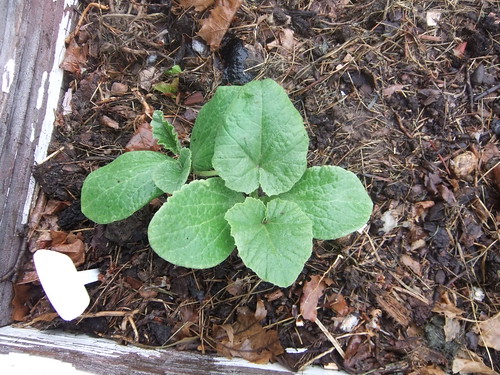|
|
Post by atimberline on Jan 14, 2009 10:01:36 GMT -5
Thanks for the info Tim, I was planning on building tripods around the Zea diploperennis plants and shrouding them in Black plastic to shorten day length, but your dustbin idea sounds a lot easier. I have been formulating a plan to work around the hardiness issue on this project. I figure that as diploperennis is rhizomus, you could just lift the corn-like F2's in autumn to identify plants that have rhizomes, and bring these rhizomus individuals into a frost free environment to overwinter. You could then back cross these perennial corn plants to sweetcorn and repeat the process of inbreeding, identification of perennial individuals, overwintering, and back crossing until you have a viable perennial population. At this point you could start selection for hardiness by collecting the seed and leaving the plants in the ground to overwinter, the following season you would just restart from seed and any surviving overwintered plants could be placed in the field to introgress the genes for greater hardiness into the larger population, and then repeat the process until you have a viable hardy population of perennial sweetcorn. I know that all this will take some time and more than a little luck, but I think it could work. Even if hardiness isn't achievable it provides a means for people in colder climates to breed a perennial sweetcorn. So what do people think, any amendments or suggestions? 'Thanks for the info Tim, I was planning on building tripods around the Zea diploperennis plants and shrouding them in Black plastic to shorten day length, but your dustbin idea sounds a lot easier.' It is soooo much easier, just flip them on, flip them off. Not many wind problems either. ...put them on sometime when plants get mid-knee high, ...in the evening. Pull them off in the morning when there is less than 12 hrs of daylight left ''I have been formulating a plan to work around the hardiness issue on this project. I figure that as diploperennis is rhizomus, you could just lift the corn-like F2's in autumn to identify plants that have rhizomes, and bring these rhizomus individuals into a frost free environment to overwinter. You could then back cross these perennial corn plants to sweetcorn and repeat the process of inbreeding, identification of perennial individuals, overwintering, and back crossing until you have a viable perennial population.' Sounds good... the problem I ran into was diseases that would rot the plants to death ...We would frost out in mid-late Sept. and not get regrowth temps until May...that is a long time to sit there and it calls for all the rot resistance you can find, esp. when the temps are largely mud-sloppy 30s-40s F. ...Of course, if you can afford to heat a place for these guys you will probably be fine. ...I always had a budget that just hovered above survival and heat was basically beyond affordable. 'At this point you could start selection for hardiness by collecting the seed and leaving the plants in the ground to overwinter, the following season you would just restart from seed and any surviving overwintered plants could be placed in the field to introgress the genes for greater hardiness into the larger population, and then repeat the process until you have a viable hardy population of perennial sweetcorn. ' That is a good basic concept, ...that is the general idea and approach I have used effectively for part of any one of my perennial grain, tomato, cuke, squash, ground cherry, etc. programs ...some things tend to nearly entirely self pollenate and with those groups you have to come up with an unique approach to the bottleneck. One other thing that I have noted, that may interest you. In wide crosses that have more than common incompatibility, if you can vegatatively propagate these individuals and keep them going, and esp if you can grow large numbers, you will on occasion as a result of genetic sluffing, mutation of any number of sorts, you will occasionally find more fertility, or better traits showing in backcrosses... that sort of thing. That is my occasional experience, and that can be the experince that make the world of difference in where your project goes. 'I know that all this will take some time and more than a little luck, but I think it could work. Even if hardiness isn't achievable it provides a means for people in colder climates to breed a perennial sweetcorn. ' ...you always have the element of chance... treasure your exceptions, you may never see the like again ...sometimes your 1 in 10 was really1 in a billion and you just didn't know it. 'So what do people think, any amendments or suggestions?' ...not much... I have a couple of good Tripsacum for you when you are readyfor them. ...start them several months ahead of setting out or it may take 2 years to bloom. |
|
MikeM
grub
  frost-free 365.25 + clayish soil + altitude 210m + latitude 34S + rain 848mm/yr
frost-free 365.25 + clayish soil + altitude 210m + latitude 34S + rain 848mm/yr
Posts: 91
|
Post by MikeM on Jan 14, 2009 10:30:55 GMT -5
I should have known there was a sticking point, diploperennis isn't winter hardy, so while those of us living in cold winter areas could make the initial crosses we would need people in warmer climates to do the grow outs and selection work. As someone living in one of those warmer climates... (warm-temperate; no frost -- at least not in the past 40-odd years; the future? who knows) I'd love to help! Additionally we would gain a North-South swing to speed things up. Right now I probably don't have enough ground, but I do have about 1000m 2 earmarked for clearing (and particularly earmarked for grains.) Let me know if I can help! |
|
|
|
Post by mybighair on Jan 18, 2009 21:59:33 GMT -5
Sorry I took so long to get back to this thread, time has been a bit short.
Tim,
I'm glad you think the plan has some merit, I appreciate the benefit of your experience and greatly value your input. I think that rotting may well be a problem here also, winters are about the same length as with you and very damp. I have zero budget to speak of and limited space and resources so heating is unlikely to be viable; at best I may be able to persuade my wife to let me keep them somewhere in house, but I wouldn't bet on it.
I understand exactly what you are saying on wide cross incompatibility. I have experienced similar things in my rose breeding and I was hoping that my experiences there would come in useful. I have been very lucky in both the rose breeding and poultry breeding in the past and achieved things much more quickly and with smaller finial populations than I should have; and I have learned never to take such good fortune for granted.
Could I inquire as to which Tripsacum you have? I would like to do some reading on the specific species.
I have some Tripsacum dactyloides seed from Gatersleden that I plan to test for hardiness and in my climate. If it survives I may try to cross it into the (Zea diploperennis X maize) line to impart grater hardiness. I prefer to avoid crossing plants with incompatible ploidy levels, and prefer diploids to triploids and polyploids as there are fewer variables; but there are situations where it's your only option.
Thanks again for your input on this.
Mike,
Climate may be the most limiting factor in this project so your involvement could be crucial to the development of a perennial corn variety. It may prove unfeasible to pursue this project in colder climates so the more people like yourself that take an interest in this project the better.
I would encourage any interested parties to make this cross if they have the means to do so. We all have limitations on the number of plants we can grow and the amount of time we can give to any project, and the more people we have involved the greater our chance that someone will obtain the perennial corn plant we need to take this project forward.
I'm really pleased that people here have taken an interest in this cross, and that it's becoming a Home Grown collaboration.
|
|
|
|
Post by atimberline on Jan 21, 2009 11:01:10 GMT -5
I have 2 Tripsacum lines that are distinct and each has some valuable traits which I will share with you via email if you wish them. ...I have a number of other landrace sels from around GA, USA where they are native. They are definitely cold hardy, base leaves often staying green to below 10 F. ...and they can survive far beow 0 F
CYMMIT has Tripsacum - maize amphiploids if any of you can access that giants materials. ...please share what you get with the rest of us, if you get any.
|
|
|
|
Post by mybighair on Jan 23, 2009 13:18:06 GMT -5
Its good to know that some Tripsacum selections are hardy to 0 F as our winters rarely drop below 5 F. I am giving consideration to making a Tripsacum/maize cross and back crossing to Tripsacum in the hope of developing a naked seeded Tripsacum hybrid. It would be interesting to see what would come from the introgression of maize genes into Tripsacum.
I cant say I'm familiar with CYMMIT, but I will certainly look them up. If I should get anything I will naturally share the material.
|
|
|
|
Post by mybighair on Mar 10, 2009 8:43:58 GMT -5
I received the Zea diploperennis seeds from Michel today and thought I'd post some pictures. The packets received from Michel 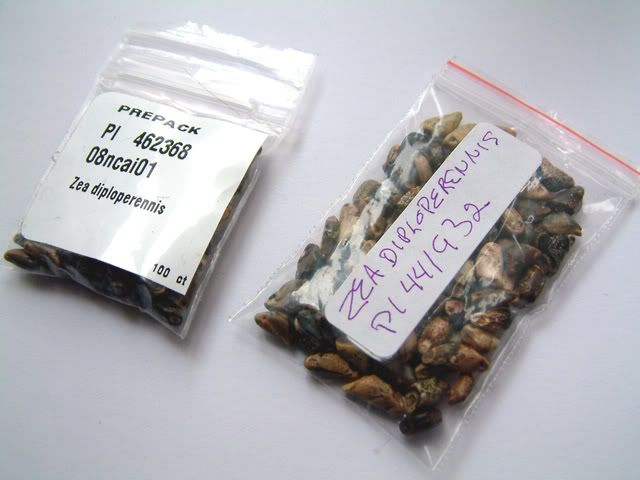 There are two accessions, and there is some variation in seed colour between them. Zea diploperennis, accession Pl 462368. 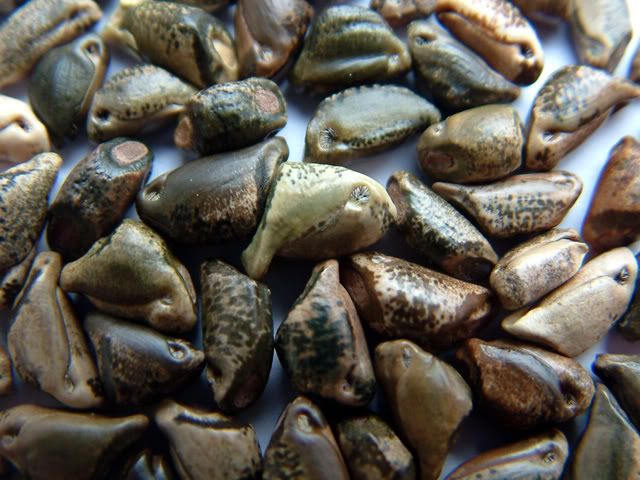 Zea diploperennis, accession Pl 441932 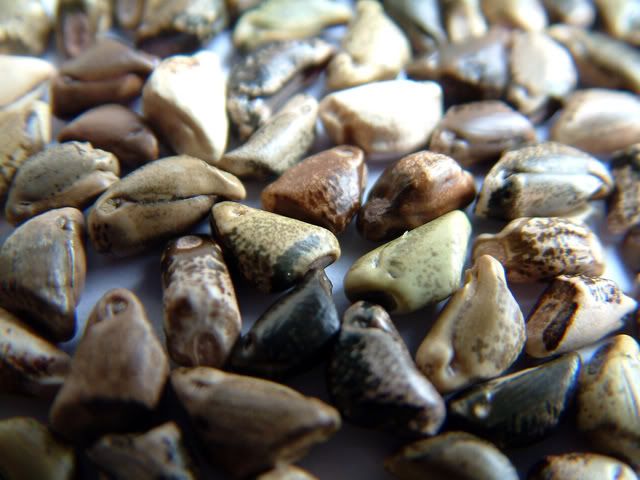 Both are quite beautiful despite being reminiscent of severed grasshopper heads and I look forward to growing them; I can only hope they survive the Welsh climate. While I'm at it I thought I should post some pictures of the Tripsacum dactyloides seeds from IPK. Tripsacum dactyloides packet from IPK 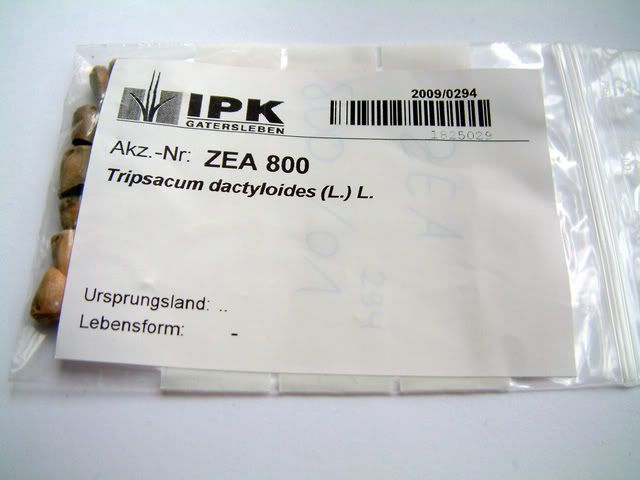 Tripsacum dactyloides seed 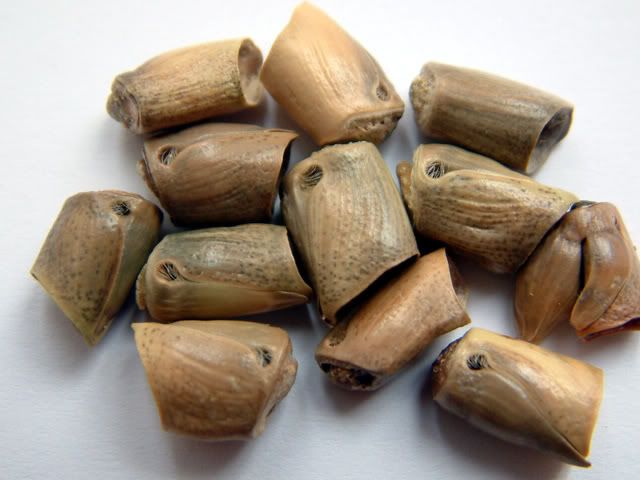 The Tripsacum seed are rather beautiful them selves, but a little less like grasshopper heads and perhaps a little rugged looking. And finally a comparison shot between the two species. Tripsacum dactyloides on the left, and Zea diploperennis on the right  |
|
|
|
Post by bunkie on Mar 10, 2009 11:29:15 GMT -5
fascinating mybighair! i was just catching up on this thread. i would like to be a prat of this project also...except i live in the north...
i was wondering about using hoophouses, or something similar and cheap, to grow this in the northern climates? they would be open and no heat, but might protect the plants from some of the elements causing disease. stress. one could slowly introduce the plants to the harsher climate in increments, in a way possibly acclimatizing them to the cold, etc....
i have mentioned elsewhere that i am presently reading the book 'The Rebel Farmer' By Sepp Holzer from Austria. in it he mentions a 'perennial Siberian original corn'. he says it reaches a height of up to two and a half meters and that it's generally harvested in the second and third year as a grain for bread. i am trying to find more info on this variety, and locate some seed. when i do i will let you know. have you heard of this man? he farms at 1,500 meters above sea level!
|
|
|
|
Post by mybighair on Mar 10, 2009 12:28:24 GMT -5
I think you could really test the hardiness of a perennial sweetcorn in your climate zone bunkie. I'm not sure that I can over winter in zone 7 but I suppose that the right cultural practice could bring the plants through in zone 5. Cant say how you would offer them enough insulation though.
Thanks for mentioning 'The Rebel Farmer' I'm not familiar with Sepp Holzer but will be looking into him now, and I'll have to get a copy of his book.
|
|
|
|
Post by raymondo on Mar 10, 2009 15:43:29 GMT -5
Great idea to pool resources and share the load. I only wish I could jump in and offer to help. Sadly, Australian quarantine would come down very hard on me over grain imports. They are strictly controlled here - biosecurity is the term they bandy about.
I will watch this space with keen interest.
|
|
|
|
Post by mybighair on Nov 19, 2010 7:41:35 GMT -5
Just thought it was time to update on this one.
Despite my best hopes the Tripsacum dactyloides was not hardy in Wales. We are only Zone 7 and I hoped one of the strains I was sent would survive, but they all died in their first winter and I was not successfully in getting them to flower. I haven't resown them yet as I am focussing on the Zea diploperennis cross.
Things are not much better on the Zea diploperennis front. I have one plant that will survive winter if heavily insulated and taken into a shed. It's the only plant to survive despite them all receiving the same treatment.
As yet I have not managed to get it to flower before things get to cold for it, let alone make the cross to corn. The problem being that it takes so long to put on enough growth after the winter dieback there isn't time to bring it into flower before the frost takes it down.
I'm beginning to think this project isn't possible in my climate. Corn breeding in Wales is proving challenging enough without throwing interspecies crosses into the mix.
Still, no harm to keep trying, I may get lucky at some point.
|
|
|
|
Post by cortona on Nov 24, 2010 17:14:38 GMT -5
if i can help you mybighair i'm in, i live in central italy so probably zone 9 or at least 8 and i have two g.h (just one are heated, let me know if i can help you!
best of luck for all your breding works!
|
|
|
|
Post by atimberline on Feb 14, 2011 15:18:29 GMT -5
Re: Zea diploperennis « Reply #39 on Nov 19, 2010, 7:41am » -------------------------------------------------------------------------------- Just thought it was time to update on this one. Despite my best hopes the Tripsacum dactyloides was not hardy in Wales. We are only Zone 7 and I hoped one of the strains I was sent would survive, but they all died in their first winter and I was not successfully in getting them to flower. I haven't resown them yet as I am focussing on the Zea diploperennis cross. NOTE: They will easily survive there for you, you just have to start them early like tomato and transplant them deep, and mulch the first winter. Or just dig the rhizomes before the hardest freezes in December, top them like iris, and replant after the worst winter freezes are over... probably sometime in March. ...Both these and the per. teosinte generally are slow growers the fist year, esp in cool - night climes. Things are not much better on the Zea diploperennis front. I have one plant that will survive winter if heavily insulated and taken into a shed. It's the only plant to survive despite them all receiving the same treatment. As yet I have not managed to get it to flower before things get to cold for it, let alone make the cross to corn. The problem being that it takes so long to put on enough growth after the winter dieback there isn't time to bring it into flower before the frost takes it down. NOTE: Again, Start the seed or rhizomes early inside, set out and get 1-2 ft of growth, start covering the plants with garbage cans eve-night, uncover in the morning-noon whenever it will give you 11 or less hours of daylight (do this religiously), and you will get them to flower during the summer. I'm beginning to think this project isn't possible in my climate. Corn breeding in Wales is proving challenging enough without throwing interspecies crosses into the mix. NOTE: These will grow under cooler conditions than most corn... you can do it there. Still, no harm to keep trying, I may get lucky at some point. Read more: alanbishop.proboards.com/index.cgi?action=display&board=corn&thread=1987&page=3#49404#ixzz1Dxs7ahCF |
|
|
|
Post by mybighair on Feb 15, 2011 6:41:53 GMT -5
Hi cortona,
Thanks for the offer of help perhaps it would be worth while collaborating with you on this one as your climate may be better suited to the project.
Hi Tim,
I will be trying again with the Tripsacum, but I'm going to wait till things have calmed down a bit. Even the plants that were heavily insulated with straw and protected under plastic didn't make it through the first winter so I may have to bring the rhizomes into the house as you suggest and go from there.
The surviving Zea diploperennis plant has surprised me with its relative hardiness, but it is very slow growing here, it barely makes it to a foot high before the frost takes it down so I'm trying it the polytunnel to see if the heat brings it on faster. It's actually planted in there this winter, I buried the pot so it was about 6in below soil level and mulched the area deeply with straw. I checked on it a few days ago and the plant is pushing through the soil about 2in already, I was expecting it to be dead as this has been one of our coldest winters in a long time, we have gone down to -18c at times. Hopefully I can get it to grow fast enough in the tunnel to try bringing it into flower.
All the best.
|
|
|
|
Post by keen101 (Biolumo / Andrew B.) on Feb 15, 2011 18:02:56 GMT -5
mybighair,
I'm not sure if growing it in a hothouse will coax it into growing faster. My experience with my Zea diploperennis last summer made me think that it's genetics are what determines it's growth pattern. Mine seemed to expend most of it's energy into it's roots, rhizomes, and tillers, and seemed to like being in a clump even when i tried to remove the tillers early on. It seemed to grow best when i stopped trying to prune the tillers. I'm not sure if mine would have been able to get to the pollen stage before winter hit, but there is a fairly good chance it would have. Unfortunately the squirrels broke of the top of the main stalk which had the immature tassels.
Hopefully mine survived the winter. But, it has gotten to -20 (F) already this winter. We will see. I hope it makes it.
this spring I will be planting a lot more either way all over the yard. I'll take pictures when i can.
...By the way... That makes me bring up an interesting question. How long can plant pollen be preserved? Can corn pollen (and by extension teosinte pollen) be collected at the end of a season in a small case, and be used the following spring to pollinate corn that does not have any tassels?
If so... It might even be possible to collect teosinte pollen and ship it to other breeders...
|
|
|
|
Post by DarJones on Feb 15, 2011 23:52:37 GMT -5
Corn pollen has a very short shelf life. Typically it lasts one day at room temp and at most a few days in refrigeration. I've seen some reports of drying followed by freezing that give longer viability.
As an aside to this question, seed viability is genetically determined. I've got some Bloody
Butcher corn that still germinates better than 50% at 15 years old. No other corn has given more than 1% germination at that age.
DarJones
|
|









